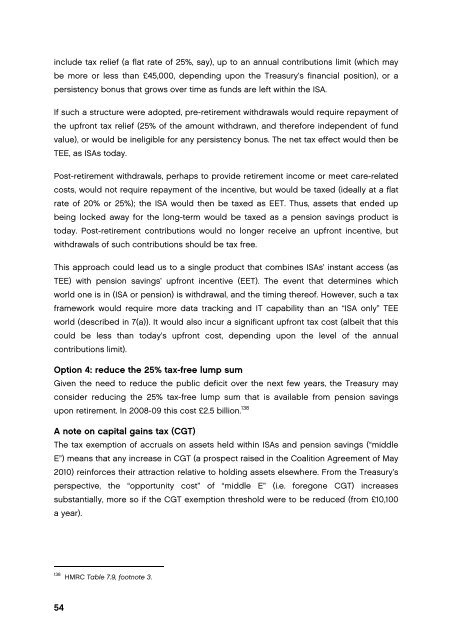Simplification is the key - Centre for Policy Studies
Simplification is the key - Centre for Policy Studies
Simplification is the key - Centre for Policy Studies
Create successful ePaper yourself
Turn your PDF publications into a flip-book with our unique Google optimized e-Paper software.
include tax relief (a flat rate of 25%, say), up to an annual contributions limit (which may<br />
be more or less than £45,000, depending upon <strong>the</strong> Treasury’s financial position), or a<br />
pers<strong>is</strong>tency bonus that grows over time as funds are left within <strong>the</strong> ISA.<br />
If such a structure were adopted, pre-retirement withdrawals would require repayment of<br />
<strong>the</strong> upfront tax relief (25% of <strong>the</strong> amount withdrawn, and <strong>the</strong>re<strong>for</strong>e independent of fund<br />
value), or would be ineligible <strong>for</strong> any pers<strong>is</strong>tency bonus. The net tax effect would <strong>the</strong>n be<br />
TEE, as ISAs today.<br />
Post-retirement withdrawals, perhaps to provide retirement income or meet care-related<br />
costs, would not require repayment of <strong>the</strong> incentive, but would be taxed (ideally at a flat<br />
rate of 20% or 25%); <strong>the</strong> ISA would <strong>the</strong>n be taxed as EET. Thus, assets that ended up<br />
being locked away <strong>for</strong> <strong>the</strong> long-term would be taxed as a pension savings product <strong>is</strong><br />
today. Post-retirement contributions would no longer receive an upfront incentive, but<br />
withdrawals of such contributions should be tax free.<br />
Th<strong>is</strong> approach could lead us to a single product that combines ISAs’ instant access (as<br />
TEE) with pension savings’ upfront incentive (EET). The event that determines which<br />
world one <strong>is</strong> in (ISA or pension) <strong>is</strong> withdrawal, and <strong>the</strong> timing <strong>the</strong>reof. However, such a tax<br />
framework would require more data tracking and IT capability than an “ISA only” TEE<br />
world (described in 7(a)). It would also incur a significant upfront tax cost (albeit that th<strong>is</strong><br />
could be less than today’s upfront cost, depending upon <strong>the</strong> level of <strong>the</strong> annual<br />
contributions limit).<br />
Option 4: reduce <strong>the</strong> 25% tax-free lump sum<br />
Given <strong>the</strong> need to reduce <strong>the</strong> public deficit over <strong>the</strong> next few years, <strong>the</strong> Treasury may<br />
consider reducing <strong>the</strong> 25% tax-free lump sum that <strong>is</strong> available from pension savings<br />
upon retirement. In 2008-09 th<strong>is</strong> cost £2.5 billion. 138<br />
A note on capital gains tax (CGT)<br />
The tax exemption of accruals on assets held within ISAs and pension savings (“middle<br />
E”) means that any increase in CGT (a prospect ra<strong>is</strong>ed in <strong>the</strong> Coalition Agreement of May<br />
2010) rein<strong>for</strong>ces <strong>the</strong>ir attraction relative to holding assets elsewhere. From <strong>the</strong> Treasury’s<br />
perspective, <strong>the</strong> “opportunity cost” of “middle E” (i.e. <strong>for</strong>egone CGT) increases<br />
substantially, more so if <strong>the</strong> CGT exemption threshold were to be reduced (from £10,100<br />
a year).<br />
138 HMRC Table 7.9, footnote 3.<br />
54

















